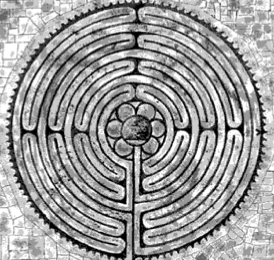For our congregation, for our communityA place to pray, to ponder – a peaceful pathway for reflection andcommunication with God
The Labyrinth at Calvin Presbyterian Church was built through the efforts of many devoted members of the church and friends from our neighboring communities. Though the Labyrinth is new to Calvin and this community, it is an ancient, sacred symbol found in many religious traditions. Various styles of labyrinth patterns can be found in cultures from all over the world, dating back 5,000 years.
This means of devotion has been used since the first days of Christianity. Early Christians took a vow to visit the Holy City at some point in their lives, but during the Middle Ages the Crusades made travel to Jerusalem unsafe. Instead, Christians built labyrinths in the floors of the cathedral entrances. By walking the path of a labyrinth, Christians found a safe means to fulfill their sacred pilgrimage vows. The center of the labyrinth symbolized Jerusalem for these early Christians, and walking the labyrinth became an important spiritual practice.
 Labyrinths can be confused with mazes – but a labyrinth is very much unlike a maze. A maze, with its walls, has dead ends and blind alleys – designed to help you lose your way. In a labyrinth, which is flat, one can always view the center, and so the mind can be still and attentive. The winding path into the center and back out again is a metaphor for the journeys of life and faith, as labyrinths are designed to help you find your way to God. As we hope to provide a little guidance about how to use a labyrinth, please know that there are no rules. The journey is yours to take as you wish – or as you are led.
Labyrinths can be confused with mazes – but a labyrinth is very much unlike a maze. A maze, with its walls, has dead ends and blind alleys – designed to help you lose your way. In a labyrinth, which is flat, one can always view the center, and so the mind can be still and attentive. The winding path into the center and back out again is a metaphor for the journeys of life and faith, as labyrinths are designed to help you find your way to God. As we hope to provide a little guidance about how to use a labyrinth, please know that there are no rules. The journey is yours to take as you wish – or as you are led.
The Labyrinth is a tool used for contemplative prayer and meditation. There is no right or wrong way to experience your journey. The goal is connecting with God – asking, seeking, and listening. You may walk with a concern or an intention you wish to lift up to God. Quietly ponder thoughts that come to you while you walk, and attend to answers that become clear after you leave. Bring your mind, body and spirit to guide your path.
If you start at the entrance to the Labyrinth and follow the pathway around its circular routes, you will find no blockades to confuse you. The destination to the center is assured.
Journeying in. The “journey in” phase, as one follows the path to the center, can be a time to shed distractions, let go and clear one’s thoughts, releasing concerns to God. You might pause at the entry to the labyrinth – pray silently or take a deep breath.
Being in the center. The center, which includes a fountain, can be the place to pause and receive God. You may stay as long as you wish.
Journeying out. This phase is a transition, a gradual returning to daily life, back out the same pathway.
You may walk straight to the center, out or in across the brick lines – or even wander around the perimeter, as you wish. If you come across others moving in the opposite direction or more slowly, please be considerate of their path, as they will be of yours. You may walk alone, with a friend or family, or simply observe. However you decide to approach the Labyrinth, please take your time and enjoy its blessings.
Our labyrinth design is modified from the one at the Chartres Cathedral in France – though smaller with fewer circuits.